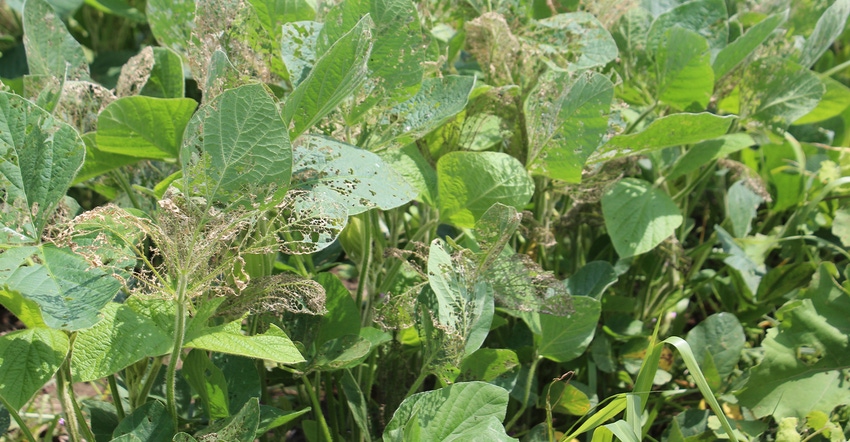
Leaf-feeding bugs strike twice during the growing season — once in spring at early vegetative stage after plant emergence, and again in summer at the reproductive stage. So scouting fields is important to protect yield.
Here is a refresher on the top pests attacking soybean fields and how to identify them.
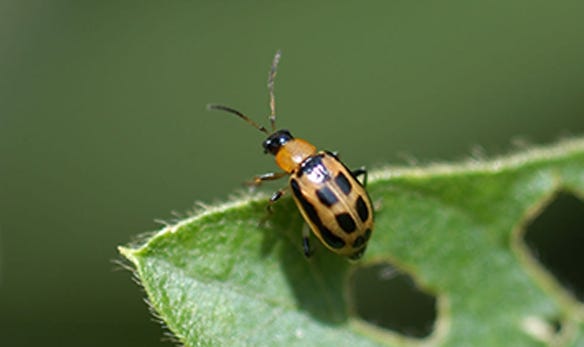
KNOW YOUR BEETLE: Bean leaf beetles have six black spots and a triangle behind their heads. They can be either red or tan in color.

Bean leaf beetle. Bean leaf beetle is the No. 1 pest throughout the U.S. soybean growing region. They have two color phases — red and tan — and can be confused with other beetles such as the southern corn rootworm and lady beetles.
Look for six black spots, a black band on the outside of its wing cover and a black triangle behind its head. Adults overwinter in alfalfa and Conservation Reserve Program fields under the leaf, so scout early.
According to researchers at Kansas State University, females laying eggs around soybean plants cause the most problems. The first-generation adults chew oval holes between leaf veins. The second generation feeds on pods, ultimately affecting seed quality.
While soybean plants can come back from defoliation, once it reaches 20% in the reproductive stage, treatment may be warranted if insects remain actively feeding.
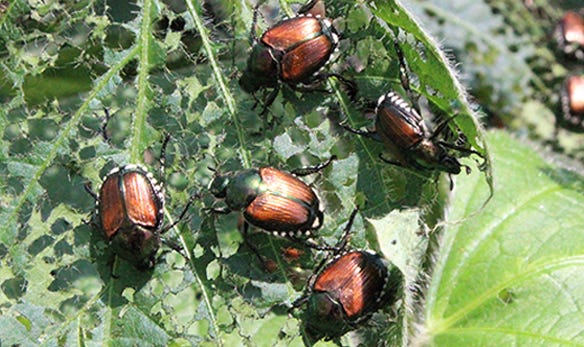
GROUP EFFORT: Spotting one Japanese beetle can signal a problem as more often follow. They have no problem feeding in a pack. Check with your agronomist for spray recommendations. The devastation looks worse than the economic effect.

Japanese beetles. With their metallic green and bronze-colored wings, the adult Japanese beetle is hard to miss. It measures a half-inch long and appears in fields from July to September.
Feeding from this beetle turns the soybean leaves into a mere skeleton, stripping away the tissue between the larger leaf veins. The damage can be mistaken for Mexican bean beetle feeding. However, the Japanese beetle destroys more of the smaller veins.
The insect causes some economic damage in soybeans but not as much as in corn, since in corn it is feeding on the tassel, which affects ear fill.
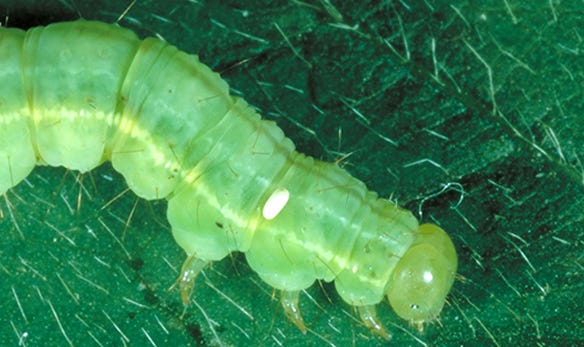
MISTAKEN IDENTITY: Farmers scouting soybean fields may see the green cloverworm and think it is a looper. The white stripe and four “legs” on each side are indicators that it is a green cloverworm.

Green cloverworms. Green cloverworm populations are increasing. Farmers may confuse this caterpillar with a looper, but it differs by having four abdominal prolegs compared with three for loopers. It also has a narrow white stripe on both sides of its body.
Green cloverworms feed on the underside of leaves. A fungus serves as a natural defense by infecting the worm, turning it white. Death occurs in two days.
To save a little money, growers can accept some damage to the plants — if not widespread — to allow the fungus to work. Otherwise, the economic threshold is 20% leaf defoliation and if 10 to 15 or more half-grown larvae are present per foot of row.
Remain alert. Adult moths do not overwinter in Missouri; they fly in. Just because a field did not have a problem last year doesn’t mean it won’t this year.

STICKING OUT: The spiny appearance matches this pest's name, thistle caterpillar. It appears along field edges. But once you see a cocoon, the damage is done. Hold off on treatment.

Thistle caterpillar. This caterpillar is brown-black in color with yellow striping on both sides. It has spiny hairs on its body that gives it a prickly appearance. It measures 1¼ inches long. As an adult, the thistle caterpillar morphs into the butterfly known as the painted lady.
These pests tend to feed along the field edges. Once a thistle caterpillar hits chrysalis, the damage is done, so look for a cocoon. If there is not much damage, less than 20% defoliation, treatment is not needed.
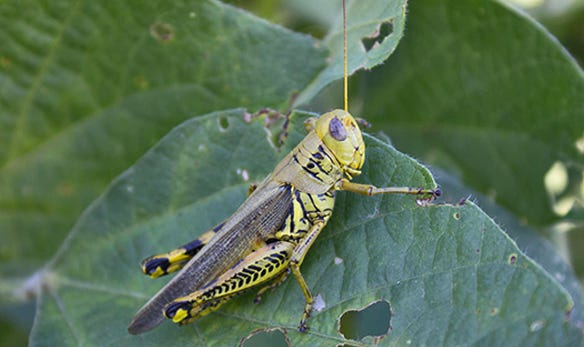
DROUGHT PROBLEM: When moisture conditions turn dry, watch out for grasshoppers. They move from field to field in search of food, often eating into soybean pods to the seed.

Grasshoppers. Grasshoppers are a problem in drought years as they move into row crops searching for food. These insects feed on soybean leaves but also may eat through the pod to the seed.
Treatment of soybean may be necessary at 40% or more defoliation before soybean flowering, 15% from flowering to pod fill, and 25% from pod fill to harvest.
About the Author(s)
You May Also Like






